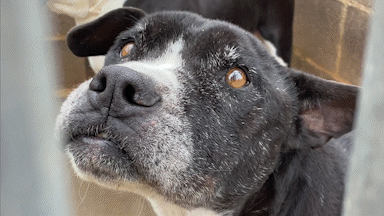
"THE BIG BLACK NANNY PITBULL"
SUCH AN EXPERT IN THE DISCARDED SPECTACLE
But what if a dog fails to comply with commands or display receptivity to expressions of affection? What if the so-called “unconditional lover” no longer expresses “love”?
Or if a seemingly simple “sit-down” leads to a series of uncooperative behavior?32
Towards temperament, domestication leads to the manipulation of fear and aggression to pave the way for sociability and enhancement of socio-cognitive abilities in species. In the case of dogs, this modification erases from the cumulative effects of centuries of selective adaptation to novel environments and unsuitable tasks,33 which may culminate in a dog’s reaction to people’s demands ranging from several perspectives: From compliance with simple commands, such as performing tricks, to resistance towards instructions like leashing for a routine walk —which is mainly resolved after a couple of minutes of hide-and-seek.—
However, this game does not always finish as expected.
32
Uncooperative situations translate into non-expected actions far away from the dog correctness desired. Over her career as a researcher on dog cognition, Alexandra Horowitz details these actions: If we assume that we have reduced the animal factor to zero, we are in for some unhappy surprises. Dogs do not always behave just as we think they should. They may sit, lie down, and roll over—but then will revert magnificently. They suddenly squat and urinate in the house, bite your hand, sniff your crotch, jump on a stranger, eat something gnarly in the grass, don’t come when you call them, and roughly tackle a much smaller dog. In this way, our frustrations with dogs often arise from our extreme anthropomorphizing, which neglects the very animalness of dogs.
Horowitz, Alexandra. Vidal, Sean. Edgerton,
Inside of a Dog: What Dogs See, Smell, and Know (New York, NY: Simon & Schuster Books for Young Readers, 2017)
33
Although the process of domestication extends as far back as 15,000 years, this discussion is centered on the most recent 150 years of dog domestication when humans became exceedingly fixated on the aesthetic and emotional characteristics that a dog ought to possess.
This is not about winners or losers, but rather a circumstance in which there is a risk of encountering situations in which dogs may display defensive behavior not accepted by humans, mostly through barking, growling, or biting. Although behavior traits are a critical factor in shaping the current identity of dogs through the process of domestication, other aspects such as morphology, vocalization, and intraspecies behavior also come to play. Consequently, failure to conform to the requirements of domestication in any of these areas frequently leads to situations that exhibit alarming effects towards the dog. In the most
unfavorable scenario and after being penalized for the exhibition of those behaviors, the dog would remain silent, ignorant of a situation that could potentially lead to the dissolution of the dog-human relationship, leaving it in a state of uncertainty regarding its future.
Will it be rehomed with another individual?
Will it become a member of the canine community at an animal shelter? Or would it be subjected to euthanasia?
Given the easy disposability that is often associated with dogs,34 any of these outcomes may be valid. On the part of the human, the termination of this relationship is often rationalized by attribution blame to the dog’s behavior, thereby enabling them to absolve themselves of any guilt associated with the decision concerning the dog’s future. In this context, the “big black nanny Pitbull” is an expert, reason why it is converted into the main role of the following narrative.
34
Despite the existence of fines for abandoning dogs, legislation against euthanasia, and protocols for microchipping identification, the practical application of these regulations differs from their purpose. For example, in the Spain it is common for hunters to remove the microchip from their greyhounds and leave them injured and tied up outside of animal shelters during the night after the hunting season in February. A practice that has earned the month with the nickname "Febrero, el mes del terror de los galgos", in English “February, the month of terror for greyhounds”
February, the month of terror for greyhounds). (Crespo Garay, Cristina “'Febrero, El Miedo De Los Galgos'.” National Geographic, February 1, 2019.
But who exactly is this dog and how can its experience provide greater insight into the current state of dog-rejected habits?
In order to comprehend the various instances of dismissed situations that this identity has encountered, it is crucial to take into account the following:
- The "big black nanny Pitbull" identity stems from two distinguishable phenomena, namely, the “big black dog syndrome” and “the nanny Pitbull.” However, their portrayal within the narrative is not uniformly distributor. Rather, the articulation of each of the phenomenon’s attributes is contingent upon the subject matter of the corresponding section, resulting in an altered emphasis throughout the narrative.
- Unlike other narratives, "The multifaceted 'big black nanny Pitbull' such an expert on discarded spectacle" does not have a single set of elements to analyze. Rather, disparate analytical frameworks will be employed in each section of the chapter, with a delineation of these resources provided at the beginning of each of them.
The contemporary-mythical simulation of the “big black nanny Pitbull”
- For the analysis of this section, the material used consists of visual content generated by Open-AI text-to-image generators, and historical research findings.
Well, the dog in question is a shorthaired dog with a solid single-layer black coat. It has a few white markings on its paws that resemble socks. Its appearance is similar to that of a Pitbull. Although not as large as a traditional mastiff breed, it still boasts well-defined musculature. It has an impressive head and stands at a height that surpasses the knees of a 1.80cm tall person. Unsure of its gender, or even its origin or belonging. The dog is currently at rest outdoors, observing children playing nearby, in a setting resembling an image that one might find in an old catalog in a thrift store.
The depiction of the “big black nanny Pitbull” exhibit a fluctuation between particularized attributes, such as its “single layer black coat hair”, and broad categorizations, exemplified when classifying it as a member of the “Pitbull family.”35 However, to what extent can these traits serve as a basis for envisioning the physical and behavioral traits of this figure?
Well, let’s incorporate other tools to support the imaginative process.
DALL-E, an AI system developed by OpenAI that employs textual descriptions to generate realistic images, is fed with a portrayal of the “big black nanny Pitbull” to contribute to the visualization process. The result? A collection of distorted dog figures, depicted in emotionally evocative scenarios involving children, some of which evoke Victorian-era sensibilities.Fig.47 While certain outcomes align with the traits that inspired them, such as the “impressive heads” feature, Fig.48 the AI’s “computer-eye”36 at times introduces complementary elements of dogs within outdoor, peripheral settingsFig.49 or with cropped ears.Fig.50
35
The expression “looks like a Pitbull” talks about a label which has become an umbrella term used to loosely describe many different medium-sized, short-haired breeds and mixes with physical traits commonly found in numerous bully-type (or bulldog-type) breeds.
PitbullHero™. “‘Pit Bull’ Is Not a Breed.”
Pitbullinfo.org. Accessed February 22, 2023
36
The “computer eye expression” is used to explain how in AI’s generative processes, not only the explicit text interferes as the unique input creator of the image. Also, as part of its training process, it considers extra-similarities commonly shared in the selected data pictures for the creation of the final piece.
OpenAI. “Dall·E: Creating Images from Text.”
OpenAI. Accessed December 20, 2022
The expression “looks like a Pitbull” talks about a label which has become an umbrella term used to loosely describe many different medium-sized, short-haired breeds and mixes with physical traits commonly found in numerous bully-type (or bulldog-type) breeds.
PitbullHero™. “‘Pit Bull’ Is Not a Breed.”
Pitbullinfo.org. Accessed February 22, 2023
36
The “computer eye expression” is used to explain how in AI’s generative processes, not only the explicit text interferes as the unique input creator of the image. Also, as part of its training process, it considers extra-similarities commonly shared in the selected data pictures for the creation of the final piece.
OpenAI. “Dall·E: Creating Images from Text.”
OpenAI. Accessed December 20, 2022
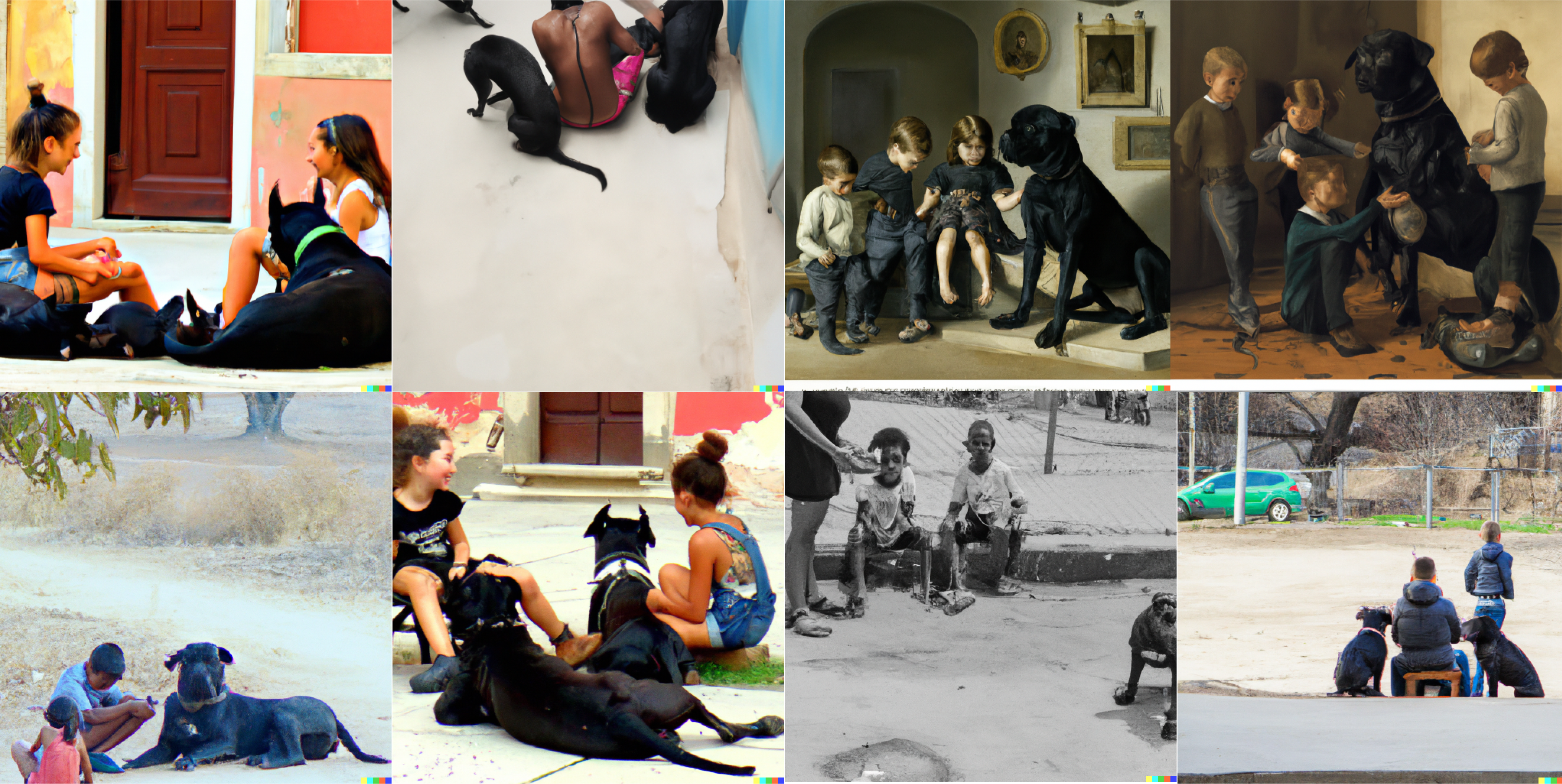
Fig.47
DALL-E x Ana Robles Pérez. Ana Robles Pérez. Diagram displaying the resulting images from DALL-E’s
processing over the analysis of the description of the “big black nanny Pitbull” Graphic element. Created January 4, 2023

Fig.48
DALL-E x Ana Robles Pérez. Diagram displaying the resulting images from DALL-E’s processing. Details on heads. Graphic element. Created January 4, 2023
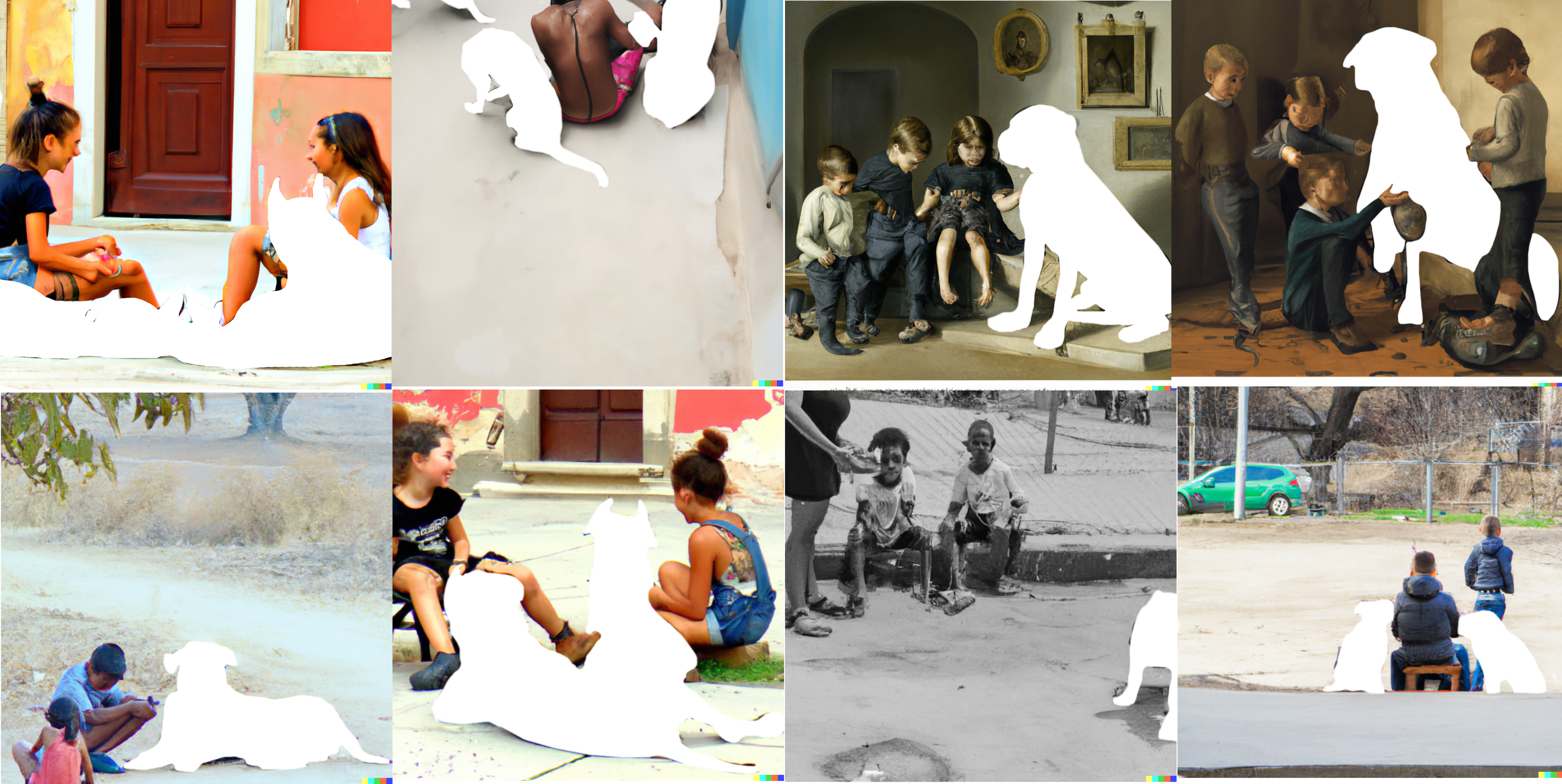
Fig. 49
DALL-E x Ana Robles Pérez. Diagram displaying the resulting images from DALL-E’s processing. Details on context scenes. Graphic element. Created January 4, 2023
DALL-E x Ana Robles Pérez. Diagram displaying the resulting images from DALL-E’s processing. Details on context scenes. Graphic element. Created January 4, 2023
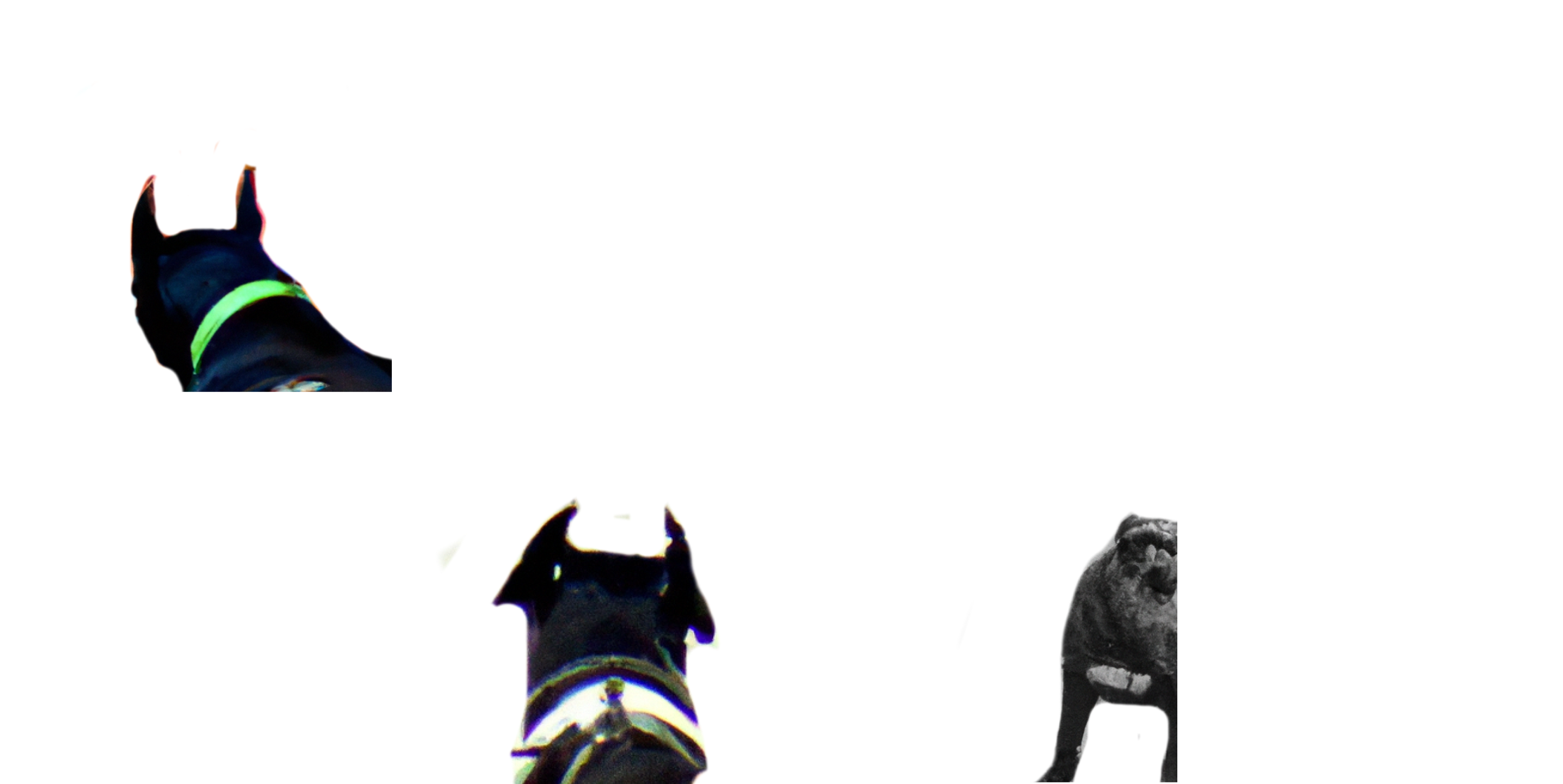
Fig.50
DALL-E x Ana Robles Pérez. Diagram displaying the resulting images from DALL-E’s processing. Details on cropped ears. Graphic element. Created January 4, 2023
But those attributes are not solely elements of fictitious dogs generated by the AI.
Rather, they constitute visual and scripted representations of two existing dog phenomena. On one hand “the nanny Pitbull” figure asserts that Pitbulls serve as exceptional nanny dogs.37 On the other hand, “the big black dog syndrome” describes the tendency for black dogs to experience lower adoption rates in comparison to lighter-colored counterparts.38
In this sense, that vintage atmosphere evoked in the “big black nanny dog” AI scene is reminiscent of traditional Victorian portraits featuring children posing alongside Staffordshire dogs,39 which served as a source of inspiration for the concept of the “nanny Pitbull.”Fig.51 Similarly, the dog’s “unknown origin” and “impressive head” paint the picture of sinister, black nocturnal creatures found in diverse cross-cultural folklores,40 which are linked to present-day biases held by individuals who, whether consciously or unconsciously, associate blackness with negative attributes.
37
This phenomenon was triggered by the 70’s article posted in The New York Times “A Breed That Came Up The Hard Way” by the President of the Staffordshire Bull Terrier Club of America, who said “The Stafford we know today quickly becomes a member of the family circle”
Rant, Lilian “A Breed That Came up the Hard Way.”
The New York Times. September 19, 1971. Accessed January 2, 2023
38
Observed by shelters and rescue groups across the world, BDS (Black Dog Syndrom) is an issue negatively affecting the adoption rates of black pets and the reason behind the phenomenon is unclear.
Nakano, Craig. “Black Dog Bias?” Los Angeles Times.
Los Angeles Times, Accessed December 12, 2022
39
No direct relation or citation has been proved
along the side of these pictures.
Rant, Lilian “A Breed That Came up the Hard Way.”
The New York Times. The New York Times, September 19, 1971.
Accessed January 2, 2023
40
Legends about black dogs are present across the legend repertory of almost any region. While their representation is quite similar, presented as evils, usually with red-colored eyes, their stories are different. From the legend of “El Perro del Escorial” in one of the most well-known Spanish monasteries, to the Moddey-Dhoo, a protagonist in Manx folklore stories.
Telemadrid. “La Leyenda Del Perro Negro De El Escorial.”
Telemadrid. Telemadrid, Accessed October 4, 2022
Marinasohma. “Not Always a Man's Best Friend: Terrifying Black Dogs of British Legends.” Ancient Origins Reconstructing the story of humanity's past. Ancient Origins, Searched January 2, 2023

Fig.51
The Truth About Pitbulls. Old pictures of “nanny Pitbulls” and kids. The Truth About Pitbull blog. Unknown origin. Searched January 4, 2023
The Truth About Pitbulls. Old pictures of “nanny Pitbulls” and kids. The Truth About Pitbull blog. Unknown origin. Searched January 4, 2023
Simultaneously, these features allude to former depictions to construct modern-day dog identities. Or does the drawing of the black CadejoFig.52—the traditional Mexican spectral dog that appears at night in solitary locations
to care for tormented drunkards—41 have something to do with the portrayal of pitbulls42 featured in the flyers disseminated over current American #banpitbulls campaigns?Fig.53
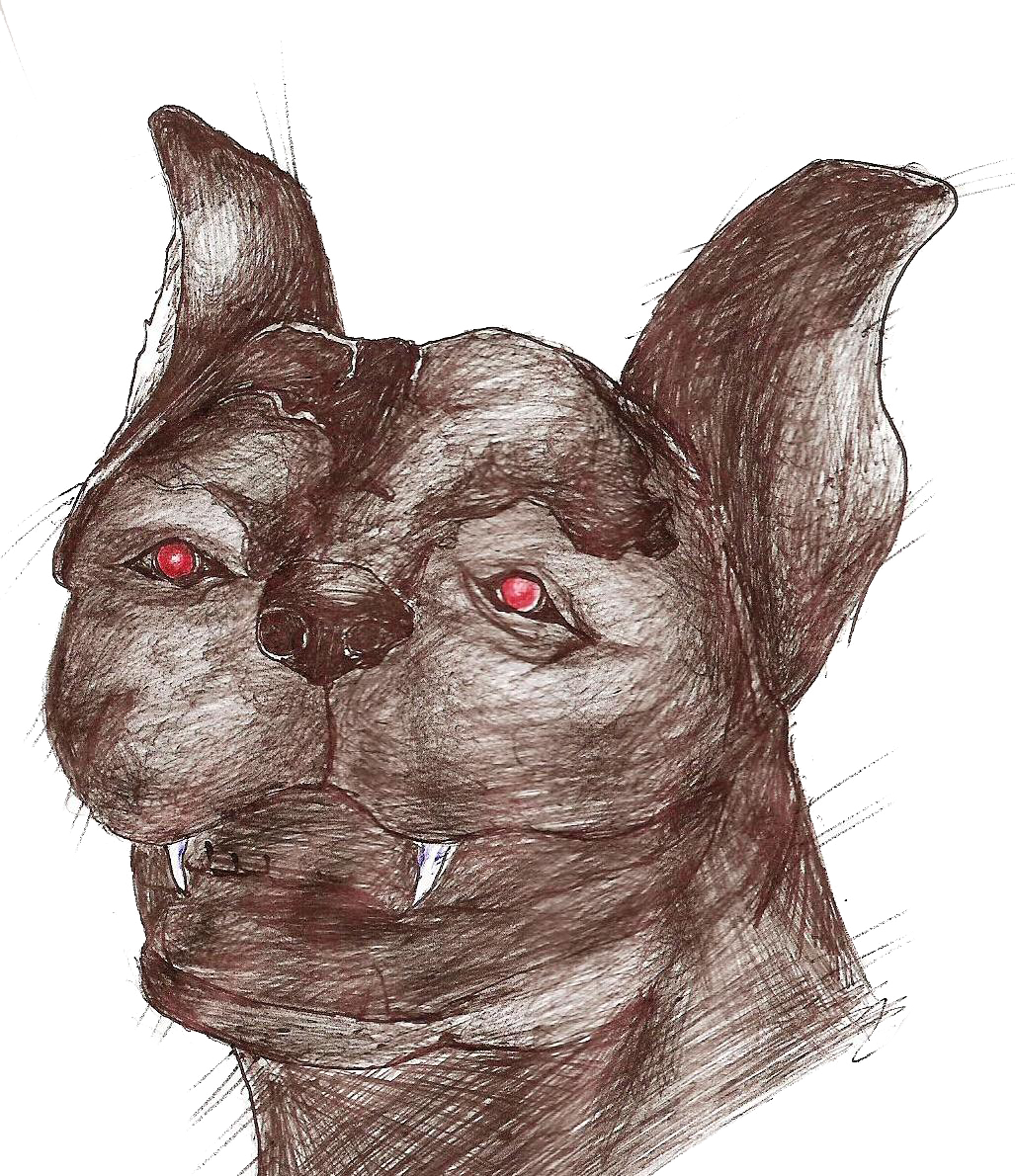
Fig.52
M. Orlando Callejas G. Artistic representation
of the black Cadejo's. Drawing. Searched December 15, 2022
41
This legend would have started based on Maya-Quiché mythology, since the Cadejo seems to be related to the nahuales. When people talk about it, theythink of a large, spectral, black dog with bright red eyes and heavy chains. But it also refers to a duality of this creature, since it includes a version of the white animal opposite to the aforementioned beast, a white one that protects children and women.
González, Mauricio. “Leyenda Del Cadejo: ¿Cuándo Se Creó?
¿Qué Significado Tiene?” guanacos. Accessed December 12, 2022.

Fig.53
Phyllis M. Daugherty. Picture of 'Ban Pit Bulls' Flyers created by @WildGoose999. and distributed over Los Angeles and Boca Raton, Florida. Picture. Searched December 15, 2022
42
#BanPitBulls flyers, with the heading "In 2017, pit bulls killed 38 humans, 13,000 dogs, 5,000 cats, 20,000 farm animals," and "Pit bulls were originally bred to kill bulls and bears." were posted widely in 2018 in Los Angeles and other cities, in Florida. Its creator known only as @WildGoose999 captured nationwide attention with tweets that are followed closely by both sides of the Pit Bull debate.
Phyllis M. Daugherty. Picture of 'Ban Pit Bulls' Flyers created by @WildGoose999. and distributed over Los Angeles and Boca Raton, Florida. Picture. Searched December 15, 2022
42
#BanPitBulls flyers, with the heading "In 2017, pit bulls killed 38 humans, 13,000 dogs, 5,000 cats, 20,000 farm animals," and "Pit bulls were originally bred to kill bulls and bears." were posted widely in 2018 in Los Angeles and other cities, in Florida. Its creator known only as @WildGoose999 captured nationwide attention with tweets that are followed closely by both sides of the Pit Bull debate.
Daugherty, Phyllis M. n.d. “‘Ban Pit Bulls’ Flyers Alarm LA Pro-Pit Bull Activists.” CityWatch Los Angeles. Accessed January 9, 2023
The “in-between” “big black nanny Pitbull”
- The analysis of this space relies on the repertoire of ideas, actions, and records from prior studies on dog activism
The Pitbull is usually depicted as menacing and hostile, much like how the black Cadejo is traditionally portrayed as dark and ominous due to its physical appearance. These stereotypical representations of both figures have sparked discussions within the multifaceted sphere of dog activism practices. One discourse maintains that so-called “status dogs,”43 or breeds such as pitbulls selectively bred by humans for intimidation, are killing machines,Fig.54 while another perspective asserts that black dogs are unsuitable for photographic purposes.Fig.55 In response, organizations such as Justice for Bullies and Black Pearl Dogs, strive to demystify these widely-held notions and promote respect and accurate representation of these dogs.Fig.56
43
Status dog is a term used to describe a potentially dangerous or aggressive dog that is kept as a symbol of the owner's hard or tough image, to intimidate others, and possibly as a weapon. This idea has persisted through centuries, tracing back to Roman times.
Wikipedia. “Status Dog.” Wikimedia Foundation, February 8, 2023

Fig.54
“Pitbulls aren’t dogs. They’re killing machines” is the title of a Reddit threat in which it is even proclaimed the disappearance of these breeds (R/Unpopularopinion - Pitbulls Aren't Dogs. They're Killing Machines.” Reddit. Accessed January 10, 2023).
Fig.55
One of the facts allowing the “Black dog syndrome” to exist, radicates on their issues to be photographed, in consequence, an issue to be adopted. (Outward Hound. Does Black Dog Syndrome Exist? Researchers Are Divided. Oh, Furtropolis. Accessed January 5, 2023)
Fig.56
The organization Justice for Bullies articulates that the “nanny Pitbull idea” “has been used by advocates in hopes of convincing the public that their dogs are good dogs, great with people and trustworthy with even the tiniest humans” (Justice for Bullies, We do NOT support the nanny Pitbull myth, Facebook Post. Accessed January 3, 2023)
Fig.56
The organization Justice for Bullies articulates that the “nanny Pitbull idea” “has been used by advocates in hopes of convincing the public that their dogs are good dogs, great with people and trustworthy with even the tiniest humans” (Justice for Bullies, We do NOT support the nanny Pitbull myth, Facebook Post. Accessed January 3, 2023)
Although individual viewpoints may vary, the overarching issue of the debate revolves around the ethical considerations, policies, and prospective fates of pitbulls and black dogs. The divergent stances, regardless of which side of the debate one falls on, offer a forum for voicing personal grievances, thereby facilitating a forum for analyzing arguments concerning:
“Top 10 reasons to adopt a black dog”
Platforms such as Blackpearldogs.com created in the mid-2000s by Tamara Delaney, an early activist against black dog syndrome, dedicate their efforts to challenge misconceptions surrounding big black dogs. They employ a strategy referred to as the “adoption commandments” wherein a list of “top 10 reasons to adopt a black dog” Fig.57 is compiled to emphasize the advantages of adopting big black dogs.
Nevertheless, it seems that this approach has been taken a little
bit far.
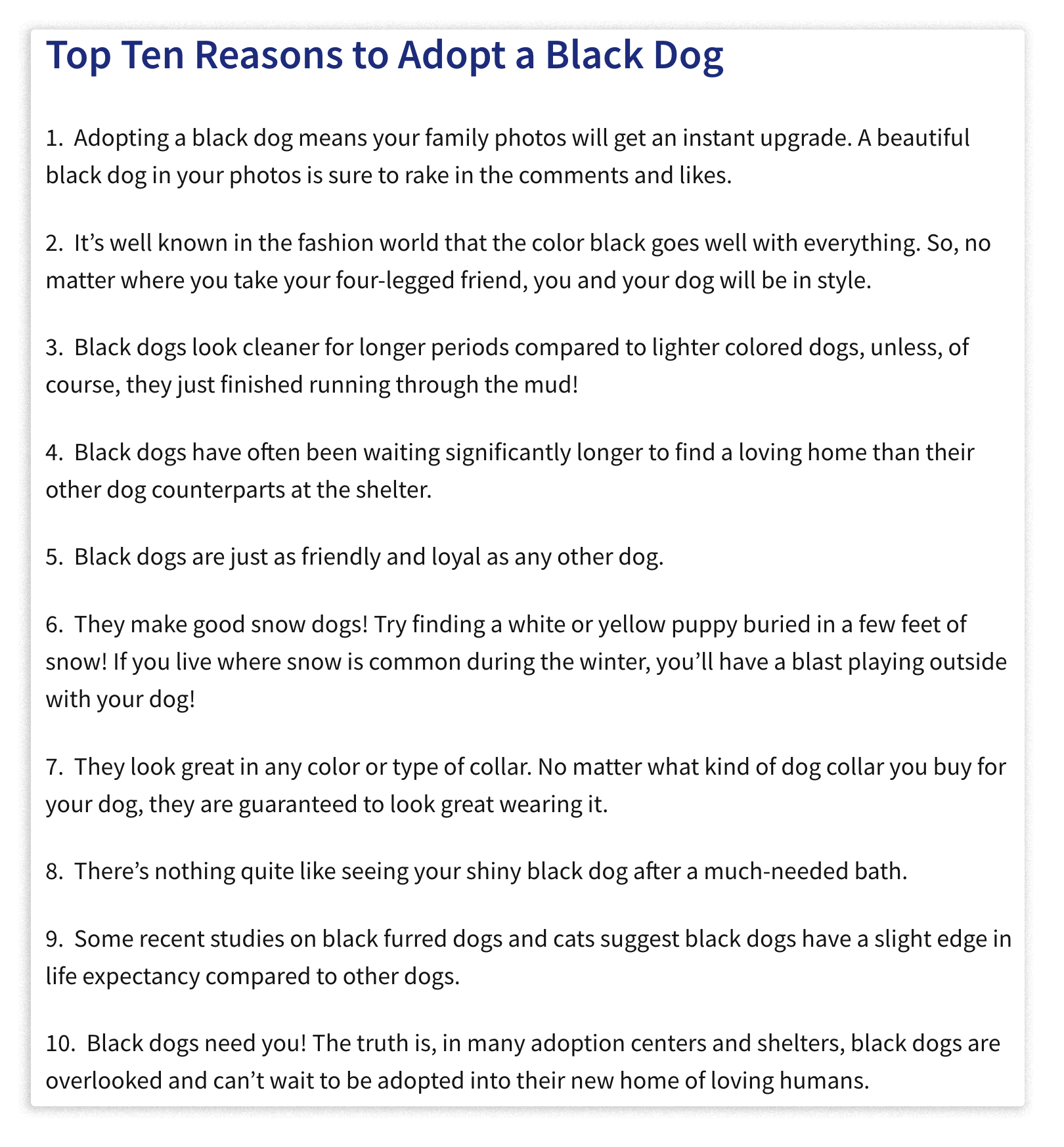
Fig.57
Adam Winsot. Screenshot of “top 10 reasons to adopt a black dog” Blackpeardogs.com article. Created January 6. 2023
Adam Winsot. Screenshot of “top 10 reasons to adopt a black dog” Blackpeardogs.com article. Created January 6. 2023
Whether it is creating a “black dog filter” to increase Social Media followers, celebrating monochromatism as suitable a canvas for any type or color of collar, or promoting big black dogs as fashionable and trendy accessories for humans.Fig.58 The reasons to adopt big black dogs, if not carefully managed, could potentially reinforce another problematic construct surrounding them.
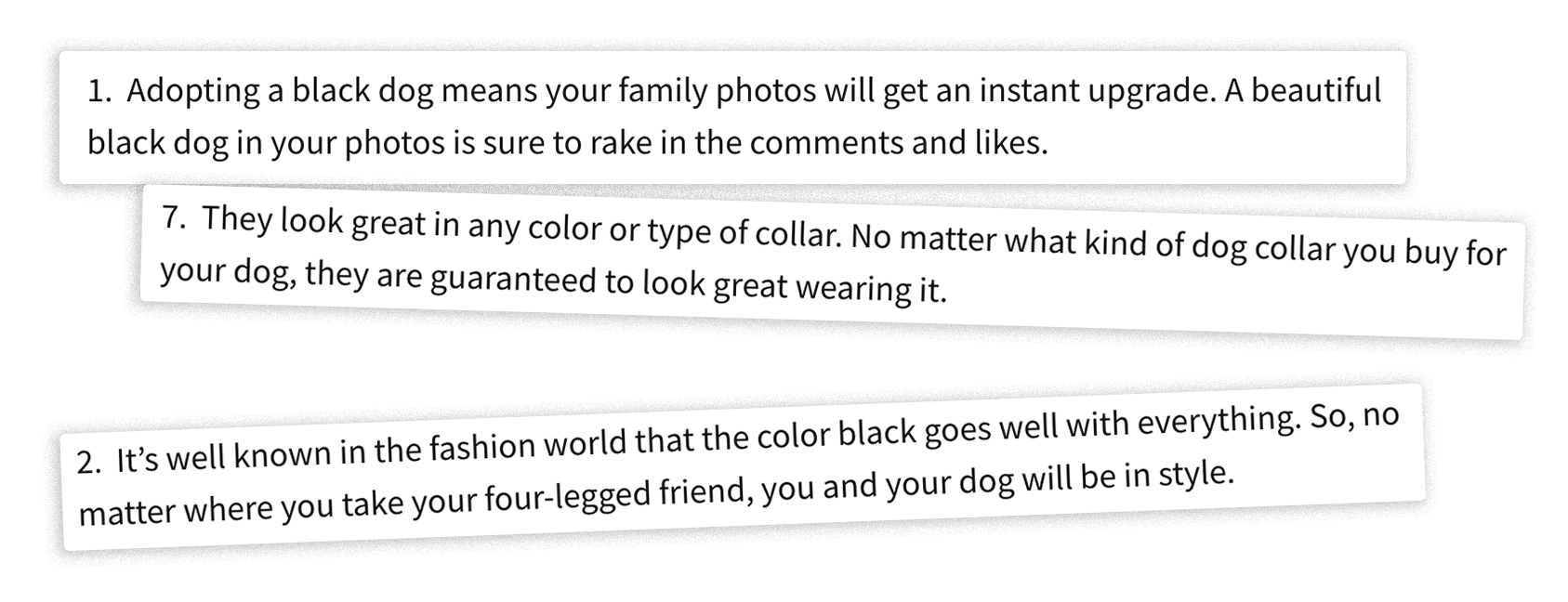
Fig. 58
Reasons nº1, 7 and 2 of “10 reasons to adopt a black dog:
(Winsot, Adam. “Black Pearl Dogs.” n.d. Black Pearl Dogs. Accessed January 9, 2023)
Reasons nº1, 7 and 2 of “10 reasons to adopt a black dog:
(Winsot, Adam. “Black Pearl Dogs.” n.d. Black Pearl Dogs. Accessed January 9, 2023)
“It's everywhere as long as you don’t
ACTUALLY search were pit bulls nanny dogs”.
ACTUALLY search were pit bulls nanny dogs”.
The archives of the digital sphere provide a diversity of resources that shape our imaginations. When it comes to exploring the concept of the “nanny Pitbull,” one finds that its origins are somewhat ambiguous. Examination of the findings reveals that various search mechanisms present a multitude of possibilities for dismantling or reinforcing this concept.
As part of this inquiry, “It's everywhere as long as you don't ACTUALLY search where pit bulls nanny dogs,” Fig.59 serves as a provocation for the “nanny Pitbull” debate, with lively discussions taking place on Reddit. The peculiar dialogue entails a range of arguments, including the use of cats as icebreakers, the disqualification of Pitbulls as nanny dogs for not being “goats,” and the use of expressions such as “poking in the eye of the dog” to test the Pitbulls’ tolerance.Fig.60
Organizations that endorse “status dogs” have publicly advocated for an end to perpetuating this debate,44 encouraging responsible dog-keeping practices similar to those opposed to the Pitbull’s image. Likewise assembled in communal digital spaces,45 the opposition refutes unfounded assertions regarding the breed’s purported advantages to prevent potential dog attacks. Despite holding divergent perspectives, both sides concur that propaganda tactics and insufficient evidence are influencing the idealized perception of pitbulls.
As part of this inquiry, “It's everywhere as long as you don't ACTUALLY search where pit bulls nanny dogs,” Fig.59 serves as a provocation for the “nanny Pitbull” debate, with lively discussions taking place on Reddit. The peculiar dialogue entails a range of arguments, including the use of cats as icebreakers, the disqualification of Pitbulls as nanny dogs for not being “goats,” and the use of expressions such as “poking in the eye of the dog” to test the Pitbulls’ tolerance.Fig.60
Organizations that endorse “status dogs” have publicly advocated for an end to perpetuating this debate,44 encouraging responsible dog-keeping practices similar to those opposed to the Pitbull’s image. Likewise assembled in communal digital spaces,45 the opposition refutes unfounded assertions regarding the breed’s purported advantages to prevent potential dog attacks. Despite holding divergent perspectives, both sides concur that propaganda tactics and insufficient evidence are influencing the idealized perception of pitbulls.

Fig.59
@u/xXdontshootmeXx Reddit user. Screenshot of the Reddit post“It's everywhere as long as you don't ACTUALLY search "where pit bulls nanny dogs'". Reddit post. Searched January 3, 2023

Fig. 60
@eilletane Reddit user. @MeshiMeshiMeshi Reddit user. @Sev-is-here Reddit user. Screenshot of comments on the Reddit post“It's everywhere as long as you don't ACTUALLY search "where pit bulls nanny dogs'". Reddit post. Searched January 3, 2023
44
Justice for Bullies,
We do NOT support the nanny Pitbull myth,
Facebook Post. Accessed January 3, 2023.

Such as the Pitbull victim support Reddit group.
“R/Banpitbulls.” Reddit community Accessed January 10, 2023